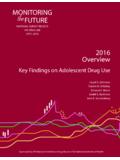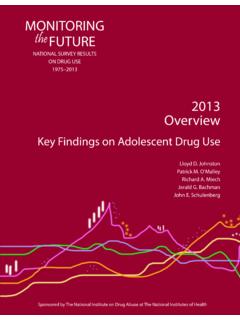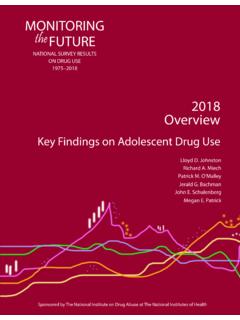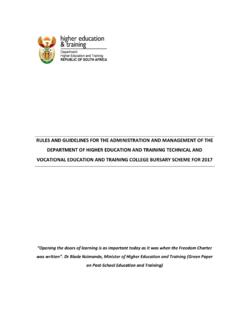Transcription of MONITORING the FUTURE
1 MONITORING . the FUTURE . NATIONAL SURVEY RESULTS. ON DRUG USE. 1975- 2017 . 2017 . Volume II. college Students & Adults Ages 19 55. John E. Schulenberg Lloyd D. Johnston Patrick M. O'Malley Jerald G. Bachman Richard A. Miech Megan E. Patrick Sponsored by The National Institute on Drug Abuse at The National Institutes of Health MONITORING THE FUTURE . NATIONAL SURVEY RESULTS ON DRUG USE, 1975 2017 . Volume II. college Students and Adults Ages 19-55. by John E. Schulenberg, Lloyd D. Johnston, Patrick M. O'Malley, Jerald G. Bachman, Richard A. Miech, Megan E. Patrick, The University of Michigan Institute for Social Research Sponsored by: The National Institute on Drug Abuse National Institutes of Health This publication was written by the principal investigators and staff of the MONITORING the FUTURE project at the Institute for Social Research, the University of Michigan, under Research Grant No. R01. DA 001411 and R01 DA 016575 from the National Institute on Drug Abuse.
2 The findings and conclusions in this report are those of the authors and do not necessarily represent the views of the National Institute on Drug Abuse or the National Institutes of Health. Public Domain Notice All materials appearing in this volume are in the public domain and may be reproduced or copied, whether in print or in non-print media including derivatives, in any reasonable manner, without permission from the authors. If you plan to modify the material, please indicate that changes were made and contact MTF at for verification of accuracy. Citation of the source is appreciated, including at least the following: MONITORING the FUTURE , Institute for Social Research, University of Michigan. Recommended Citation Schulenberg, J. E., Johnston, L. D., O'Malley, P. M., Bachman, J. G., Miech, R. A. & Patrick, M. E. (2018). MONITORING the FUTURE national survey results on drug use, 1975 2017 : Volume II, college students and adults ages 19 55.
3 Ann Arbor: Institute for Social Research, The University of Michigan. Available at #monographs Institute for Social Research The University of Michigan Ann Arbor, Michigan Published July 2018. ABBREVIATED CONTENTS*. Click on any item below (in blue) to go directly to that page. Detailed Contents .. iv List of Tables .. viii List of Figures .. xi Chapter 1 Chapter 2 Key Findings: An Overview and Integration Across Five Populations ..7. Chapter 3 Study Design and Procedures ..64. Chapter 4 Prevalence of Drug Use in Early, Middle, and Later Adulthood ..78. Chapter 5 Trends in Drug Use in Early and Middle Adulthood ..135. Chapter 6 Attitudes and Beliefs About Drugs Among Young Adults ..241. Chapter 7 The Social Context ..299. Chapter 8 Prevalence of Drug Use Among college Students and Their Noncollege Peers ..372. Chapter 9 Trends in Drug Use Among college Students and Their Noncollege Peers ..386. Chapter 10 Study Publications.
4 441. *See next page for Detailed Contents. iii DETAILED CONTENTS. Click on any item below (in blue) to go directly to that page. Chapter 1 Surveys of Young Adults and Adults Ages 35, 40, 45, 50, and 55 ..2. Surveys of college Students and Noncollege Peers ..3. General Purposes of the Chapter 2 Key Findings: An Overview and Integration across Five Populations ..7. Trends in Drug Use The Advent of Cohort Effects ..7. Male Female Differences in Illicit Drug Use ..21. Trends in Alcohol Use ..22. Male Female Differences in Alcohol Use ..22. Trends in Cigarette Smoking and Male Female Differences in Cigarette Smoking ..24. Vaping ..24. Drug Use by 8th Grade ..25. Summary and Conclusions ..26. Chapter 3 Study Design and Procedures ..64. Research Design and Procedures for the 12th Grade Surveys ..64. The Population under The Omission of Dropouts ..65. Sampling Procedures and Sample Weights ..65. Questionnaire Administration.
5 66. Questionnaire Research Design and Procedures for the 8th and 10th Grade Surveys ..66. Mode of Questionnaire Forms and Sample Proportions ..67. Research Design and Procedures for the 12th Grade Follow-up Surveys ..68. Follow-Up Procedures ..68. Follow-Up Questionnaire Format ..69. Representativeness and Sample Accuracy ..69. School Participation ..69. Student Participation ..71. Sampling Accuracy of the Estimates ..72. Panel Surveys ..72. Validity of Measures of Self-Reported Drug Consistency and Measurement of Trends ..74. Chapter 4 Prevalence of Drug Use in Early, Middle, and Later Adulthood ..78. Replicability of The Importance of Adjusted Lifetime Prevalence Estimates ..80. iv DETAILED CONTENTS (continued). Prevalence of Drug Use across Age Groups ..81. Prevalence Comparisons for Subgroups of Young Adults ..90. Gender Differences ..90. Regional Differences ..92. Population Density Differences ..94. Chapter 5 Trends in Drug Use in Early and Middle Recent Trends in Drug Use among Young Adults Ages 19-28.
6 136. Longer-Term Trends in Early and Middle Adulthood ..140. Trends for Important Subgroups of Young Adults ..152. Gender Differences in Trends ..152. Regional Differences in Trends ..161. Population Density Differences in Trends ..168. Chapter 6 Attitudes and Beliefs about Drugs among Young Perceived Harmfulness of Drugs ..241. Personal Disapproval of Drug Use ..249. Cohort Differences and Their Implications for Prevention and Theory ..254. Chapter 7 The Social Peer Norms among Young Adults (Ages 18-30) ..300. Perceptions of Close Friends' Attitudes (Ages 18 to 30) ..300. Trends in Peer Norms (Ages 18 to 30) ..301. Adults' Exposure to Drug Use through Friends and Others (Ages 18 to 55) ..304. Exposure to Drug Use (Ages 18 to 55) ..304. Trends in Exposure to Drug Use (Ages 18 to 55) ..307. Implications for Validity ..311. Perceived Availability of Drugs among Adults (Ages 18 to 55) ..311. Perceived Trends in Perceived Availability.
7 313. Chapter 8 Prevalence of Drug Use Among college Students and Their Noncollege Peers ..372. Definition of college Prevalence of Drug Use among college Students versus Their Noncollege Peers ..373. Gender Differences in Prevalence of Use among college Students and Their Noncollege Peers ..376. Chapter 9 Trends in Drug Use among college Students and Their Noncollege Peers ..386. Trends in Prevalence, 1980- 2017 : college Students versus Those Not Enrolled in college and 12th v DETAILED CONTENTS (continued). Gender Differences in Trends among college Students ..400. Chapter 10 Study Publications ..441. Adolescents' prescription stimulant use and adult functional outcomes: A national prospective Age-related changes in associations between reasons for alcohol use and high-intensity drinking across young adulthood ..441. Age-specific prevalence of binge and high-intensity drinking among U. S. young adults: Changes from 2005 to 2015.
8 442. Alcohol mixed with energy drink use during young adulthood ..442. Competitive sports participation in high school and subsequent substance use in young adulthood: Assessing difference based on level of contact ..443. Current high-intensity drinking among 8th and 10th grade students in the United States ..443. The developmental course of community service across the transition to adulthood in a National sample ..444. Do alcohol use reasons and contexts differentiate adolescent high-intensity drinking? Data for high school seniors, 2005-2016 ..444. Frequent binge drinking among adolescents, 1991-2015 ..445. Gender- and age-varying associations of sensation seeking and substance use across young High-intensity and simultaneous alcohol and marijuana use among high school seniors in the ..446. High-intensity drinking and nonmedical use of prescription drugs: Results from a national survey of 12th grade students ..446.
9 How collegiate fraternity and sorority involvement relates to substance use during young adulthood and substance use disorders in early midlife: A national longitudinal study ..447. Inverse propensity score weighting with a latent class exposure: Estimating the causal effect of reported reasons for alcohol use on problem alcohol use 15 years later ..447. Joint effects of age, period, and cohort on conduct problems among American adolescents from 1991 through 2015 ..448. Marital status as a partial mediator of the associations between young adult substance use and subsequent substance use disorder: Application of causal inference methods ..448. Passing on pot: High school seniors' reasons for not using marijuana as predictors of FUTURE use ..449. Patterns of high-intensity drinking among young adults in the United States: A repeated measures latent class analysis ..449. Patterns of simultaneous and concurrent alcohol and marijuana use among adolescents.
10 450. Prevalence and attitudes regarding marijuana use among adolescents over the past decade ..450. Prevalence of concussion among adolescents and correlated factors ..451. Prospective associations of 12th grade drinking intensity and age 19/20 driving-related consequences in a national sample ..451. vi Reasons for vaping among 12th graders: A latent class analysis ..451. Risk is still relevant: Time-varying associations between perceived risk and marijuana use among 12th grade students from 1991-2016 ..452. A sequential mixed-mode experiment in the national MONITORING the FUTURE Study ..452. Substance use behaviors and the timing of family formation during young adulthood ..453. Technology and interactive social media use among 8th and 10th graders in the and associations with homework and school adolescent alcohol use by race/ethnicity: Consumption and perceived need to reduce/stop use ..454. Other Data on Correlates and Website.












